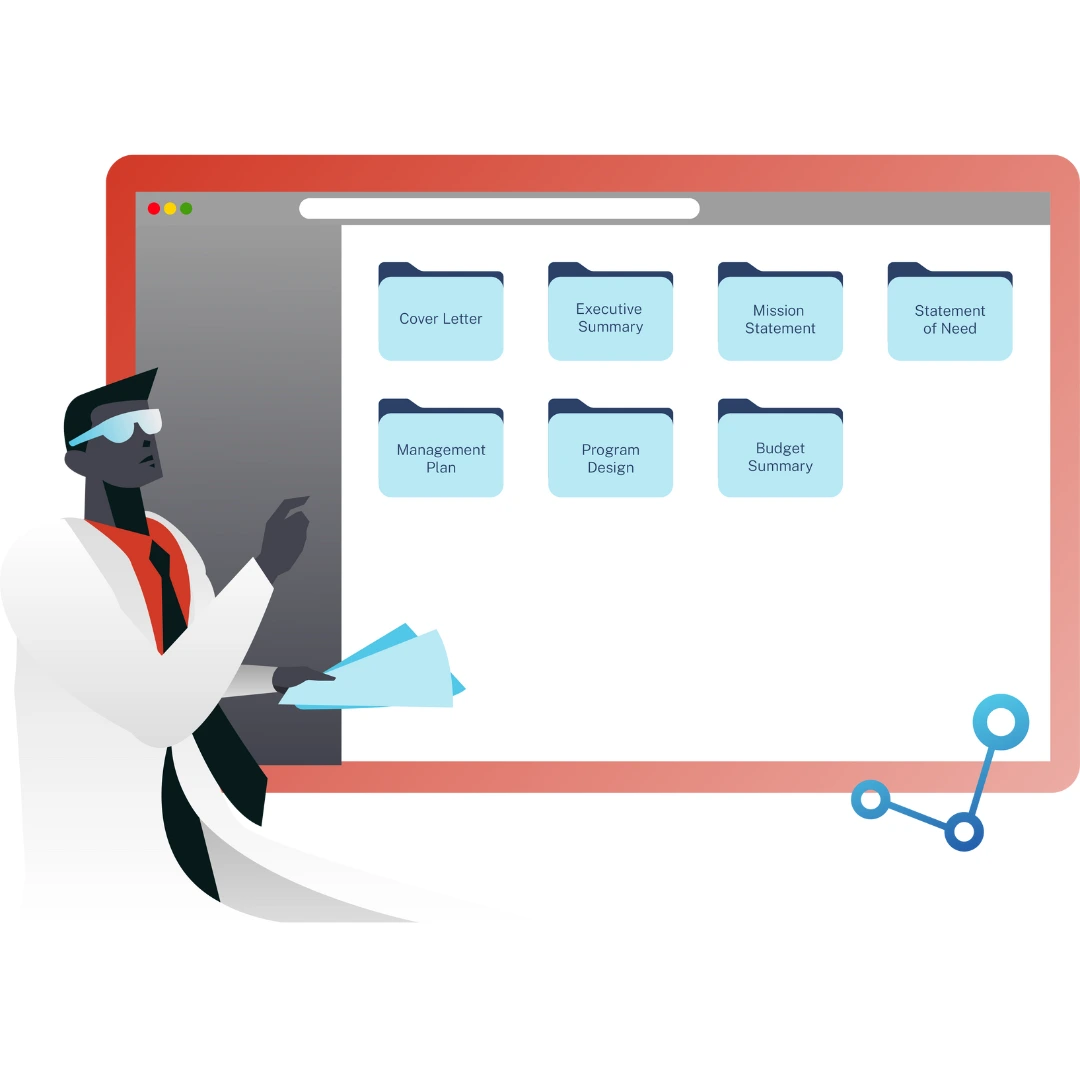Grant Writing Tips: Building a Powerful Proposal Content Library for Social Services Organizations

In today’s fast-paced world, responding quickly and effectively to grant opportunities is crucial for success. After all, fortune favours the swift—and the well-prepared. Discover essential grant writing tips and learn how creating a Grant Proposal Content Library can transform your grant writing process.
Key Takeaways
Understand the Importance of a Grant Proposal Content Library: Learn how it can help you respond to grant applications more efficiently. Because who has time to reinvent the wheel every time?
- Explore a Detailed Framework:
Get a step-by-step guide to building a comprehensive grant proposal. We promise it’s more exciting than assembling flat-pack furniture. - Leverage Expert Insights:
See how the Proposal Lab’s expertise can assist you in optimizing your grant proposals. - Get Started with Our Free Downloadable Framework:
Access our detailed Grant Proposal Content Library Framework to begin building your own content library today. Who doesn’t love free resources?
Introduction
Imagine racing against time to submit a grant application that could secure crucial funding for your organization. The clock is ticking, and the pressure is mounting. It’s like being in an action movie, but without the dramatic soundtrack. Sound familiar? For many social services organizations, this scenario is all too common. But what if there was a way to make this process smoother, faster, and more effective?
Enter the Grant Proposal Content Library—your secret weapon for efficient grant applications. Think of it as the Swiss Army knife in your grant writing toolkit. In this post, we’ll unveil essential grant writing tips and a comprehensive framework to help you build your content library, streamline your grant writing process, and increase your chances of success. And we’re here to guide you every step of the way.
The Importance of a Grant Proposal Content Library
In the competitive world of funding opportunities, time is of the essence. And let’s face it, who wouldn’t like to have more hours in the day? A Grant Proposal Content Library is a repository of well-crafted, reusable content that can be tailored quickly to meet specific grant requirements.
With this library at your fingertips, you can swiftly respond to grant opportunities, giving you a competitive edge. It enhances efficiency by saving time—you won’t need to start from scratch with each application. Consistency is maintained across all proposals, ensuring your messaging is cohesive and professional. Moreover, the effectiveness of your proposals improves with pre-vetted, high-impact content ready to be customized as needed.
Introducing a Detailed Framework for Grant Proposals
Building a robust content library starts with understanding the key components of an effective grant proposal. Consider this your recipe for grant-writing success—no cooking skills required. Below is a step-by-step framework tailored for social services organizations.
1. Cover Letter
Begin your proposal with a personalized cover letter addressed to the funder. Introduce your organization and the specific program for which you’re seeking funding. Clearly state the purpose of the proposal and express gratitude for the funder’s consideration. Think of it as the handshake before the conversation—firm, friendly, and leaves a good impression. A warm, personalized cover letter sets a positive tone for your proposal and establishes an immediate connection.
Why It’s Important: The cover letter is often your first impression on a potential funder. And as they say, you never get a second chance to make a first impression. It humanizes your proposal, allowing you to convey enthusiasm and sincerity. By thoughtfully crafting this section, you demonstrate professionalism and genuine interest, which can significantly influence the funder’s receptiveness to your application.
2. Executive Summary
The executive summary serves as an elevator pitch for your proposal. Imagine you’re sharing your vision between the lobby and the top floor—make every word count. Briefly introduce your organization and highlight the significance of the program. Summarize the critical need your program addresses and outline how your solution effectively tackles this need. Keep it compelling and concise to engage the reader from the outset.
Why It’s Important: Funders often review numerous proposals; a strong executive summary can capture their attention quickly. Think of it as your proposal’s movie trailer—intriguing enough to make them want to see the whole film. It provides a snapshot of your entire proposal, making it easier for decision-makers to understand your objectives and the impact of your program. A well-crafted executive summary can entice the funder to read further.
3. Mission Statement
Present your organization’s mission statement, emphasizing its relevance to the program and alignment with the funder’s priorities. Highlight how the program reflects shared values and objectives. Demonstrating this alignment shows funders that you’re working towards common goals.
Why It’s Important: Aligning your mission with the funder’s interests establishes a connection on a fundamental level. After all, harmony isn’t just for music. It reassures the funder that their investment will support initiatives that resonate with their mission and values. This alignment increases the likelihood of securing funding.
4. Organizational Background
Provide a brief history of your organization, focusing on experience relevant to the program area. But remember, brevity is the soul of wit—keep it concise. Showcase significant achievements and describe current operations and initiatives related to the program. Offer data on the communities you serve and detail partnerships that enhance program delivery.
Why It’s Important: Establishing credibility is crucial in gaining a funder’s trust. By highlighting your organization’s background and successes, you demonstrate your capacity to deliver results. This section reassures funders that an experienced and competent team will manage their resources effectively.
5. Statement of Need
Articulate the community needs your program addresses by presenting data and statistics on the issue both locally and provincially. Explain how the issue affects the community and its implications. Highlight the immediate need for funding and reference studies or reports supporting the program’s necessity. Justify why the program is essential for vulnerable populations.
Why It’s Important: The statement of need creates a compelling case for why your program is necessary. It’s where you tug at the heartstrings while appealing to the mind. It connects the funder emotionally and logically to the problem you’re addressing. Demonstrating a deep understanding of the issue and its impact can motivate funders to support your efforts to create meaningful change.
6. Program Design
Clearly express the primary purpose of your program and adjust program goals to mirror those of the funder. Consider it customizing a suit—it needs to fit just right. Define clear and specific objectives using the SMART criteria—Specific, Measurable, Achievable, Relevant, and Time-bound. List key activities that will occur upon receiving funding and describe expected outcomes and impacts on the community. Articulate how the program’s goals and objectives will lead to the desired outcomes among the target population.
Integrate an evaluation plan detailing how the program’s success will be measured. Because what gets measured gets managed. Specify the indicators and tools that will track progress toward goals. Explain how you will acknowledge and promote the funder’s support and outline plans for sustaining the program beyond the grant period.
Why It’s Important: A detailed program design demonstrates that you have a strategic and actionable plan. It’s your blueprint, not just a sketch on a napkin. It shows funders that their investment will be used effectively to achieve tangible results. Including evaluation and sustainability plans further assures funders of your commitment to accountability and long-term impact.
7. Management Plan, Assets, and Equity
Identify team members and their roles, specifying how much time each will dedicate to the program. After all, even the best plans need the right people to execute them. Highlight internal
resources and partner contributions that will support program execution. Demonstrate your commitment to equity through inclusive hiring practices and equitable outreach efforts.
Why It’s Important: Funders want to know that the right people are in place to execute the program successfully. Remember, even the best orchestra needs a skilled conductor. A strong management plan showcases your team’s expertise and readiness. Emphasizing equity and inclusivity aligns with many funders’ priorities and reflects a holistic approach to community development.
8. Budget Summary and Narrative
Provide a financial overview with a summary table of the budget. Think of it as showing your work in math class—it proves you know what you’re doing. Explain each budget item clearly and detail how you will allocate the funds. Transparency in your budget builds trust with funders and shows that you have a solid financial plan.
Why It’s Important: A transparent and well-justified budget assures funders that you are fiscally responsible. Nobody wants to fund a mystery—clarity is key. It demonstrates that you have carefully planned how to use the funds to achieve program objectives. Clear financial planning reduces uncertainty and increases confidence in your proposal.
9. Capability-Related or Supporting Documents
Include letters of support from partners or community leaders to endorse your program. It’s like getting references for a job application—they vouch for your credibility. Add testimonials from beneficiaries to showcase the real-world impact of your work. Highlight previous successes and include impact reports to provide evidence of your organization’s effectiveness.
Why It’s Important: Supporting documents serve as tangible proof of your organization’s credibility and the value of your work. Think of them as the applause after a great performance—they show you’re appreciated. They offer external validation and can significantly strengthen your proposal by providing evidence of community support and successful outcomes.
Leveraging The Proposal Lab’s Expertise
We understand that building a comprehensive Grant Proposal Content Library can be daunting. That’s where our expertise comes into play. We specialize in providing grant writing tips and guiding organizations through the proposal development process.
One of our clients, a mid-sized nonprofit focused on youth services, struggled with tight deadlines for grant applications. After working with us, deadlines became less of a nemesis and more of a friendly reminder. By helping them develop a tailored content library, they reduced their proposal preparation time by 50% and secured several significant grants.
Conclusion
Building a Grant Proposal Content Library is more than just a time-saver; it’s a strategic asset that can significantly enhance your grant application process. It’s the difference between scrambling last minute and confidently hitting ‘send.’ By following this comprehensive framework and implementing these grant writing tips, you position your organization to respond to opportunities swiftly and effectively, increasing your chances of success.
Remember, the key to efficient grant proposals is preparation, organization, and leveraging expert insights. As the saying goes, “By failing to prepare, you are preparing to fail.” Let’s choose success instead.
Ready to transform your grant writing process?
- Download our free, detailed Grant Proposal Content Library Framework to get started on building your own content library. Click here to download.
- Contact The Proposal Lab today for professional assistance in customizing your grant proposals.
- Share this post with your network to help others streamline their grant applications.
Unlock your organization’s full potential with a powerful proposal content library. After all, we can turn the grant-writing marathon into a well-paced sprint together. Let’s secure the funding you need to make a lasting impact together.
